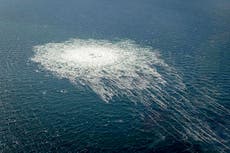US coast guard confirms Chinese and Russian warships off Alaska
Seven vessels from China and Russia were seen in formation off Aleutian Islands
The US Coast Guard in Alaska came across Russian and Chinese vessels on an ordinary patrol earlier this month, the agency has said.
In an announcement on Monday, the agency said the surprise encounter with a formation of Russian and Chinese ships came came on 19 September about 75 miles north of Kiska Island, in the Aleutian Islands of Alaska.
That was when the USCGS Kimball, a US Coast Guard vessel, spotted a guided missle cruiser from China in the Bering Sea off Alaska’s coastline.
While announcing an ongoing counter-response this week, the US Coast Guard said it soon spotted two other naval ships from China along with four Russian naval vessels that were inside the US Exclusive Economic Zone (EEZ) that surrounds the Alaska coastline and that of the Aleutian Islands.
“As a result, the Kimball crew is now operating under Operation Frontier Sentinel, a Seventeenth Coast Guard District operation designed to meet presence with presence when strategic competitors operate in and around US waters,” the agency said on Monday.
“The US Coast Guard’s presence strengthens the international rules-based order and promotes the conduct of operations in a manner that follows international norms,” the statement continued, while adding that “the Kimball will continue to monitor activities” to ensure safety of the EEZ.
The encounter comes almost a year after the US Coast Guard spotted Chinese ships about 50 miles from the Aleutian Island chain in the Bering Sea, the agency said, and a month after warnings from the head of NATO about increasing military activity in the Arctic region.
NATO Secretary General Jens Stoltenberg said during a visit to Canada last month that China’s growing interest in the Arctic and Russia’s military buildup in the region were growing threats to NATO’s alliance.
Russia has been returning to Soviet-era Arctic military bases and Beijing has recently declared itself a “near Arctic” state, Mr Stoltenberg said, while adding that the Arctic is becoming increasingly accessible for weapons testing as a result of the climate crisis.
“Beijing and Moscow have also pledged to intensify practical cooperation in the Arctic,” Mr Stoltenberg said while in Alberta. “This forms part of a deepening strategic partnership that challenges our values and interests”.
Rear Adm Nathan Moore, Seventeenth Coast Guard District commander, added in statement of the recent encounter: “While the formation has operated in accordance with international rules and norms, we will meet presence-with-presence to ensure there are no disruptions to US interests in the maritime environment around Alaska.”
Alaska and Russia are about 55 miles apart at the narrowest point, according to Alaskan authorities, while two islands in the Bering Sea controlled separately by the US and Russia are roughly 2.5 miles apart and in winter, can be connected by ice.
Join our commenting forum
Join thought-provoking conversations, follow other Independent readers and see their replies
Comments


Bookmark popover
Removed from bookmarks